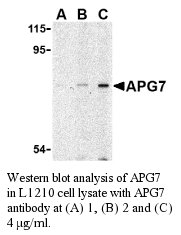Anti-Human Autophagy protein 7 (NT) (APG7)
| Code | Size | Price |
|---|
| LEI-A248-20ug | 20 ug | £199.00 |
Quantity:
| LEI-A248-0.1mg | 0.1 mg | £591.00 |
Quantity:
Prices exclude any Taxes / VAT
Overview
Host Type: Rabbit
Antibody Clonality: Polyclonal
Regulatory Status: RUO
Target Species: Human
Applications:
- Immunohistochemistry- Paraffin Embedded (IHC-P)
- Western Blot (WB)
Shipping:
Ambient
Storage:
This polyclonal antibody is stable for at least one week when stored at 2-8°C. For long term storage aliquot in working volumes without diluting and store at -20°C in a manual defrost freezer. Avoid Repeated Freeze Thaw Cycles.
Images
Further Information
Concentration:
0.5 mg/ml
Conjugate/Tag/Label:
Purified No Carrier Protein
Format:
This polyclonal antibody is formulated in phosphate buffered saline (PBS) pH 7.4 containing 0.02% sodium azide as a preservative.
Formulation:
This polyclonal antibody is formulated in phosphate buffered saline (PBS) pH 7.4 containing 0.02% sodium azide as a preservative.
Immunogen:
PN:A260
Long Description:
Autophagy, the process of bulk degradation of cellular proteins through an autophagosomic-lysosomal pathway is important for normal growth control and may be defective in tumor cells. It is involved in the preservation of cellular nutrients under starvation conditions as well as the normal turnover of cytosolic components.1,2 This process is negatively regulated by TOR (Target of rapamycin) through phosphorylation of autophagy protein APG1.3 Another member of the autophagy family of proteins is APG7 which was identified in yeast as a ubiquitin-E1-like enzyme; this function is conserved in the mammalian homolog.4 In mammalian cells, APG7 is essential for autophagy conjugation systems, autophagosome formation, starvation-induced bulk degradation of proteins and organelles.5 It has been suggested that caspase-8 may alter APG7 levels and thus the APG7 program of autophagic cell death.6
Target:
APG7
References
1. Gozuacik, D. and Kimchi, A. (2004) Oncogene. 23:2891-906. 2. Kisen, GO. et al. (1993) Carcinogenesis 14:2501-5. 3. Kamada, Y. et al. (2000) J. Cell. Biol. 150:1507-13. 4. Mizushima, N. et al. (1998) Nature 395:395-8.



